"There are no weeds, and no worthless men. There are only bad farmers." |
Victor Hugo – Les Misérables |
Some years ago, a close friend of mine told me a rather lovely story about the American Civil War. Confederate Commander Robert E. Lee, he told me, was a big fan of French author Victor Hugo's seminal novel Les Misérables. So well known was this fact amongst his own men, the story goes, that when the war started going badly for the South, the soldiers began referring to themselves as 'Lee's Miserables'. It sounded too good to be true, and over the years I came to realise that it was probably was too good to be true. Not so long ago, however, I recalled this anecdote and, with the World Wide Web now at my disposal, I did a little research. The timelines certainly fit (the book was published two years before the end of the American Civil War and was translated into English and widely read outside of France), and a number of sources attested to Lee's fondness for Victor Hugo and a few even referenced this very story. Somewhat more convincing was J. Tracy Power's compellingly detailed and meticulously researched study of the experience of Rebel soldiers in the final year of the Civil War, which is tellingly titled Lee's Miserables: Life in the Army of Northern Virginia from the Wilderness to Appomattox. It opens with a quote from author John Esten Cooke from his 1898 work, Mohun: or, The Last Days of Lee and His Paladins that confirms and provides more detail on this intriguing anecdote, revealing that the book was widely read by Lee's soldiers and that it was not only the unknowingly mispronounced French title that they had adopted to reflect their fate, but its English translation, The Wretched.
It's a bit of a shame that this extraordinary novel is now best known as the inspiration for a multi-award winning stage musical and a film version of the same. I know that were both hugely popular works, with the West End stage production running for so long that its billboard became part of the landscape, one that you could comfortably use to give tourists directions even if you hadn't been to London for a couple of years. Yet I have to confess that I have little time for either. Then again, I'm not a big fan of musical theatre and especially of musicalising great works of literature, and do appear to be in good company when it comes to the movie version.
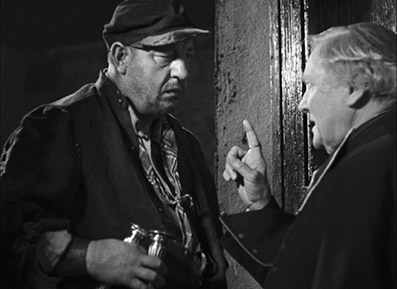
There have, it should be noted, been a lot of film adaptations of Hugo's novel over the years, one of the very first being a 1912 French version directed by Albert Capellani and starring Henry Krauss, whose final film was, a tad ironically, the 1934 adaptation under examination here. One suspects that the casting was not coincidental – his role as Monseigneur Myriel here is a small but pivotal one – and must constitute one of the earliest examples of giving a cameo role to the lead player of the film you are effectively remaking. It's a fitting swansong given that, all these years later, this is still widely regarded as the finest of all film adaptations of the novel.
It begins when a convict named Jean Valjean – who is serving a disproportionately long prison term for stealing a loaf of bread to feed his starving sister and her family, and fourteen more for his subsequent attempts to escape – is released early after using his considerable strength to help prevent a statue on the local town hall from collapsing. Like modern-day sex offenders, however, he is tarred with his crime for life, and is required to carry and present to town officials a passport declaring his ex-convict status and a statement of the danger he represents to society. Arriving at the town of Digne, he is refused entry to every boarding house he approaches, but is willingly taken in by the town's kindly bishop, Monseigneur Myriel, who gives him food and a bed for the night. Valjean's response is a little bemusing, as instead of gratefully accepting this offer, he angrily bellows at the Monseigneur, "Didn't you hear what I said? I'm a convict just out of prison! I'm very dangerous!" If he didn't want the room, you might think, then why enquire about it in the first place? Perhaps a better question might be, is he so jaded from his years in prison and the attitude of others since his release that he cannot make sense of the Monseigneur's kindness? The Monseigneur stands his ground and Valjean accepts his offer, but wakes up early the next day and absconds with the silver cutlery his host insisted be used for their meal. Again, this seems to make little sense on the surface. Valjean was never a professional thief, and has enough money earned from his years of hard labour to get by without the aid of a set of silver spoons. But the implication is clear, that far from rehabilitating Valjean, 17 years of prison have most effectively criminalised him.
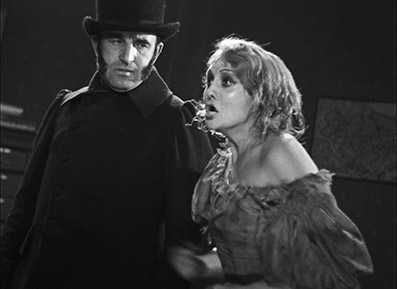
The very same day Valjean is returned to the Monseigneur's door by a small posse of policemen, who have found the stolen spoons in his possession. So what does the saintly Monseigneur do? He not only claims that he gave the cutlery to Valjean as a present, but insists that he takes a pair of silver candlesticks too. Valjean is bemused by the Monseigneur's generosity. "I know you will use this silver to become an honest man," the Monseigneur assures him. Just a few miles down the road, Valjean proves him wrong by stealing a 40 sous coin from a distraught young boy. Jeez, it's hard to like this guy. It's as the boy runs off that Valjean has the epiphany we've been hoping for, and he tears up his passport with a vow to change his ways.
In the next scene we're transported to a sizeable and well-to-do garden party, where we get our first glimpse of the attractive Fantine, who is known to be cautious with her virtue but is targeted nonetheless by one of the local young cads. Eight years later that encounter has left Fantine alone and with a young daughter named Cossette, whom she has been forced to leave in the care of innkeepers Monsieur and Madame Thénardier. She now works tirelessly in a factory in the district of Montreuil-Sur-Mer to pay for her own rent and the upkeep of a child whom, unbeknown to her, the unpleasant Thénardiers treat as a slave. When Fantine finds herself at the mercy of a hostile and deceptive factory supervisor and the feckless greed of the Thénardier family, she is forced onto the streets and into prostitution. As her health deteriorates, the widely respected local mayor, Monsieur Madeleine, comes to her aid. Except that Madeleine is none other that Jean Valjean, who has made good on the now late Monseigneur's faith in his ability to turn his life around. With Fantine on her death bed, Valjean promises to bring Cosette to her that evening, but he has been recognised by local police chief Inspector Javert, whose suspicions land Valjean with an even more problematic task to complete this very same night.

Les Misérables is a substantial novel, and this close-to five hour film version is remarkably faithful to it, yet while a lot of narrative ground has been covered by this point, in some ways it's just the set-up for developments to come. There's another time-jump that sees Cosette come of age and that puts Valjean in further conflict with both Javert and the even more desperate Thénardier family. We've also yet to meet Marius, a dashing young would-be revolutionary who loses his heart to Cosette, despite the objections of his wealthy but staunchly royalist father and the protective Valjean. And I've barely touched on the complex narrative web through which seemingly every character in the story is interconnected. Thus while Marius is attempting to court the 16-year-old Cosette, he makes friends with the young but still politically committed Gavroche, whom he at this point does not realise is the youngest child of his landlords, Monsieur and Madame Thénardier, from whom Cosette was taken by Valjean some years earlier. His love for Cosette, meanwhile, makes him blind to the infatuation of the Thénardiers' daughter Éponine, whose adoration of a man she is never destined to marry will one day save his life. Javert, meanwhile, remains doggedly determined to capture a man whose crimes are of little real significance and whose good deeds have long since wiped his moral slate clean. Yet seemingly every time Valjean has made good and settled down, Javert is there ready to bugger it all up.
These story threads all come to a most satisfying head in a vivid recreation of the 1832 Paris Uprising, as Marius, Valjean, Javert and Gavroche all find themselves at the barricades (Javert as a spy, Gavroche as possibly the most committed and upbeat child revolutionary in film and literary history). It's here that a film that has already proved its worth (and then some) as both drama and cinema goes into overdrive. Occupying a substantial portion of the film's third act, the preparations for the Uprising are grippingly handled, and the funeral parade during which the conflict is due to explode is both nail-bitingly tense and striking in its scale. The battle, when it comes, is thrillingly staged and aligns us firmly with the revolutionaries by keeping us on the barricades with them and by ensuring that their injuries of deaths register far more forcefully than those of the royalist soldiers, despite a calm humanist plea from one republican not to shoot a guardsman because underneath the uniform he is no different from them.
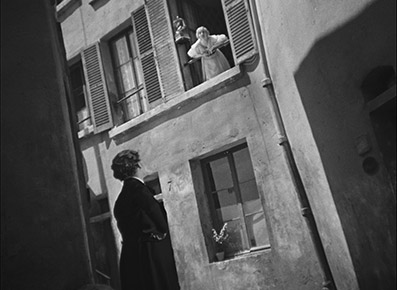
Originally released as three separate films over a period of three weeks – Une tempête sous un crâne [A Storm Beneath a Skull], Les Thénardier [The Thénardiers] and Liberté, liberté chérie [Freedom, Dear Freedom] – Les Misérables was directed by Raymond Bernard, whom the press release for this Blu-ray release claims is one of the most overlooked filmmakers of early French cinema. It may have a point. This is certainly the first film of his that I've seen, and on the basis of his direction here (he also acted as producer and co-wrote the screenplay) I have a feeling I've been seriously missing out. Given the year of the film's production, there is a real sense that Bernard was experimenting with a medium that had only recently discovered how to speak. This is particularly true of his use of the tilted camera – the so-called 'Dutch Tilt' – which while sometimes used to subtly up the level of tension or sense of impending danger, at others feels almost arbitrarily employed, a purely compositional choice rather than one made for specific narrative or emotional purpose. On four separate occasions the passing of time is economically handled by a dissolving between two identically framed shots in which the content has changed – this peaks as a technique when we are informed of Valjean's prison escape by a shot of the bars on the window of his cell that dissolves to one in which the bars are broken and bent out of shape. And in a move that looks forward to the multi-camera coverage that has become the standard on big budget features, he sometimes shoots scenes from more angles than would be considered the norm for cinema of the period – the sequence in which an old woman approaches the dejected Valjean to tell him where he might find a room for the night is covered by four separate shots when convention dictates that it requires only one.
But perhaps the most unexpected element in a film of this vintage is the use of hand-held camera during scenes of physical conflict, and while this lends an appropriate energy and physicality to Valjean's fight with Thénardier's cronies, its use during the climactic barricade battles is – somewhat appropriately – genuinely revolutionary. Like the incongruous TV crew that gets up close and personal in Peter Watkins' groundbreaking 1964 docudrama Culloden, Bernard's camera (or should I more correctly say, cinematographer Jules Kruger's camera) places us in the midst of the conflict by referencing a style of cinematic photojournalism that had not yet come to pass. Bernard and Kruger weren't emulating the visual style of war cameramen, they were anticipating it, a touch of cinéma vétité employed thirty years before the term was first officially coined.
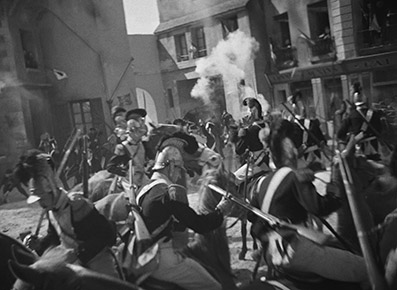
There are a couple of elements that I wasn't completely comfortable with, bugged as I was by the portrayal of the Thénardiers as just the sort of dishonest, money-grabbing and unremittingly amoral family that oily scumbags like Ian Duncan Smith and Daily Mail editor Paul Dacre like to paint every council house tenant and unemployed adult as these days. A degree of balance is provided by the well-to-do tosser who knocks Fantine up and then promptly abandons her to her fate, but he's in and out of the story in a heartbeat, while the Thénardiers have the whole second film named after them. But like our very own Charles Dickens, Hugo is not targeting specific people for their class or social status, but the ways in which poverty damages them, and by association society at large. And while social mobility may seem to be presented here as catch-all solution to all of life's woes, it's shown to be a perilously fragile two-way street, offering opportunities for betterment to Valjean just as it plunges the once secure Fantine into abject and ultimately life-destroying destitution.
If you're new to Les Misérables then you can still do no better than to read Victor Hugo's beautifully textured novel. But if you're looking for a film adaptation that is both faithful to the source and a compelling and socially relevant drama in its own right, then you can do no better than Bernard's hugely involving and technically forward-looking work. The characters may just occasionally be painted on broad strokes, but it's hard to fault the excellent cast on any level. Harry Baur in particular is superb in the lead role of Jean Valjean, a part that requires him to convince both as a brutish and physically intimidating ex-con and a respected and attention-shy pillar of society, both of which Baur handles with real aplomb. That said, he nearly has his thunder stolen by young first-timer Émile Genevois as Gavroche, whose energy and enthusiasm for the revolution is an infectious delight.
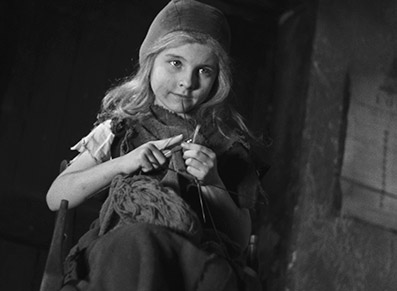
One final thing. If by some chance you find the prospect of watching a four-and-three-quarter hour film adaptation of an eighteenth century novel just a little intimidating, remember that it is presented as three separate films and can be comfortably watched that way if you so please. But be warned, I had planned to do just that, but on finishing the first I just could not wait until the following morning to watch the second, and ended up staying up half the night to see the whole thing. A tremendous achievement both as drama and cinema, Les Misérables is further evidence, if any were needed, that great literature can also make for genuinely great cinema.
The 4K restoration used for this transfer was conducted by Pathé in 2012, and I have little doubt that the term 4K will help to build expectations to an unrealistic level. There may be more information on the transfer in the accompanying booklet, but we don't have a copy at the time of going to press so have only our eyes and assumptions to rely on. It would be fair to say that the image quality varies a lot here, and I'm guessing this is down to the condition of the material from which this restoration has been made. At its worst, picture detail is soft and indistinct, while at its best it is gloriously crisp and sharp, and this can change from one to the other on a shot-by-shot basis, at least in the first film. There appears to be more consistency in the second and (particularly) the third film – the variance is still there, but the softer shots are rarer and the sharper ones more common. Grain can also vary, being occasionally quite coarse and at other times so fine you can hardly detect its presence. But when the image quality is good, it's really good, and is absolutely rock solid in frame throughout. The tonal range is also very pleasing, with black levels only occasionally softened to retain shadow detail. A few odd dust spots and traces of damage remain, but most have been very effectively cleaned up.
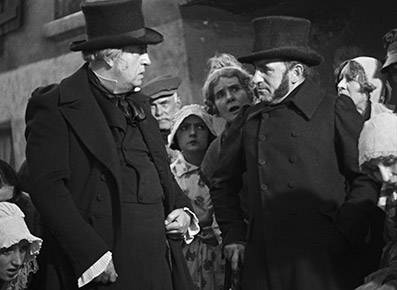
The Linear PCM 2.0 mono soundtrack shows its age in the narrow dynamic range and some detectable background fluff and hiss, but there are no obvious traces of damage or wear and the dialogue and music are all clearly reproduced. Curiously, the sound level on the third film is slightly lower than on the first two – raise the volume a couple of notches and you'll be fine, but I'd turn it down again for the extra features.
Victor Hugo in Cinema (22:49)
Claudine Cohen, researcher and lecturer at the École des Hautes Études en Sciences Sociales, discusses Victor Hugo's novel and early French film adaptations, from which sequences are usefully included for comparative purpose. The affable and consistently interesting Cohen talks about the problems of adapting the novel for the screen, the dual Christ figures of Myriel and Valjean, how a film can compress 50 pages of book into a single brief sequence, which were the hardest scenes to adapt for cinema, and a whole load more. The significance of casting Henry Krauss as Myriel in Bernard's version is also discussed, as is the impressive opening shot, and Cohen clearly holds this particular adaptation in very high regard. The interview is conducted in French with optional English subtitles.
Raymond Bernard (11:22)
An archive interview with director Raymond Bernard, who talks about his and co-screenwriter André Lang's determination to be faithful to Hugo, the importance of casting the right actors and the chance meeting that gave him the perfect Gavroche, the use of various compositional and editing techniques to capture the tone of Hugo's writing, and his horror at seeing the cut version on TV. He also suggests that the reason for the film's success lies in the love that those who made it brought to the work they did. An invaluable inclusion, this is again in French with optional English subtitles.
Raymond Chirat (18:41)
French cinema specialist Raymond Chirat outlines just what makes this adaptation of Hugo's novel so special, in the process discussing the structure of the script, Raymond Bernard's research and attention to period detail, the visual influences on the film, and the work of the lead actors, with particular emphasis on Harry Baur and Charles Varnel. Another strong extra, also in French with optional English subtitles.
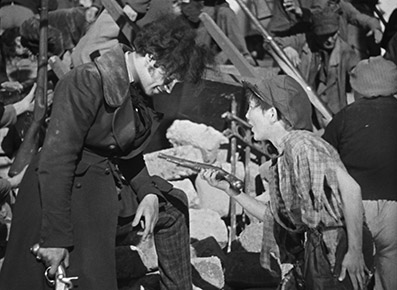
Gavroche Screen Tests (1:58)
Hugely valuable and interesting stuff, grabbed from a Pathé newsreel article on the casting of this role.
Deleted Scenes (2:39)
Two deleted scenes, bookended by shots from the finished film to show how they would have originally played. The scans include the sprocket holes, but the second includes soundtrack and is in impressive shape.
Newsreels (3:35)
Two extracts from film-related Pathé newsreels of the period. The first is a brief record of a gala event in which the actors in costume are paraded before an appreciative audience. In the second, young Gaby Triquet (who plays Cosette as a child in the film) reads the Victor Hugo poem Little White Beds, which is illustrated with filmic imagery.
Theatrical Trailer (3:35)
Has this been restored or reconstructed from the restored print of the film? I can't help but suspect the latter. Either way, it's in spanking shape – even the text is rigidly solid and sharp in frame. Includes the revolutionaries singing La Marseillaise, which always brings a tear to my eye.
Le Chemineau (1905) (3:39)
An adaptation of the second book of Les Misérables, in which Jean Valjean is given lodging by Bishop Myriel, this silent short manages to compress a sizeable portion of the novel into a thrifty three minutes (the running time includes a textual introduction). The ending is missing, but the rest is in remarkably good condition.
Also included is a 40-page booklet with new and vintage writing, rare archival material, and more, but this wasn't available for review. Our fault for forgetting to ask for a copy.
If you're looking for an introduction to one of the great works of 19th Century French literature, or know the book and have longed to see a faithful film adaptation, or just fancy an evening in the company of a three-part masterwork of early French sound cinema, then Bernard Raymond's Les Misérables is definitely for you. It's a consistently enthralling and intermittently thrilling film, and despite some image quality inconsistencies, the transfer and the extra features serve it handsomely. Wonderful stuff, and highly recommended.
|